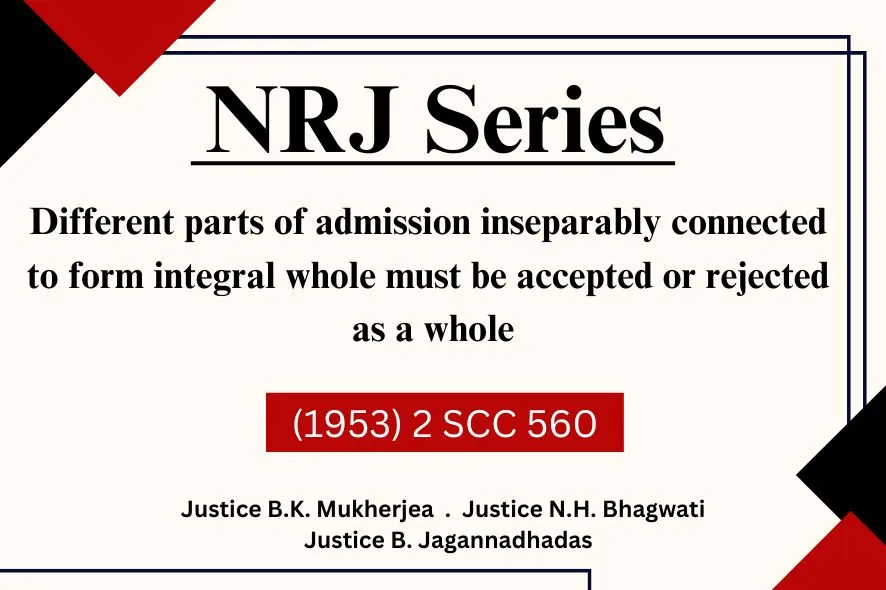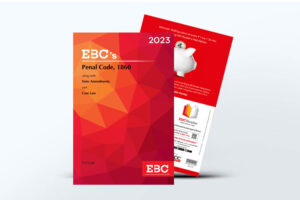Supreme Court: The present appeal was filed against the judgment of the High Court of Allahabad (‘the High Court’), confirming the conviction and death sentence passed on appellant for murder, by the Sessions Judge, Moradabad (‘the Sessions Judge’). The 3-Judges Bench of B.K. Mukherjea, N.H. Bhagwati*, and B. Jagannadhadas, JJ., held that in the present case, inculpatory part of the statement of appellant was so connected with exculpatory part as to be inseparable from it and thus, the High Court was not justified in acting only upon inculpatory part and holding appellant guilty of offence of murder. The Supreme Court allowed the appeal and appellant was acquitted, discharged, and set at liberty.
Background
In 1950, appellant’s uncle was murdered and three people, namely, Chhatrapal Singh, Dharamvir Singh, and Krishna Singh were convicted for his uncle’s murder by the Sessions Judge and were sentenced to transportation for life. The High Court, on appeal, however, acquitted all three accused and thus, appellant lodged a report against four people, namely, Chhatrapal Singh, Sardar Singh, Virendra Singh, and Satyadeo Singh alleging that they had come to his house and had threatened to teach him a lesson.
Thereafter, appellant collected around 125 people from neighbouring villages and organised a raid on the houses of two people, namely, Jagannath Singh and Sardar Singh. Thereafter, both of them died, and Rajju Singh, son of Sardar Singh, was seriously injured. At the end of the raid, all the three bodies were taken to a place known as Tiraha and from there, the dead bodies of Jagannath Singh and Sardar Singh were taken away and disposed of in a manner that they had not been traced at all. It was alleged that Rajju Singh was still alive, and appellant asked for his body to be brought to his house, and he shot him dead inside his house. It was also alleged that this was done to set up the case that some of the Thakurs had raided appellant’s house and one of the Thakurs was shot dead by appellant in exercise of the right of private defence of his person and property. It was further alleged that with the same object in view, appellant sent for a niece of his, Premkala, and asked one Chandersen, to shoot her dead and he in obedience, fired at Premkala twice causing her instantaneous death. It was also alleged that appellant asked his cousin Shanker Lal to give a gunshot wound to him and Shanker Lal accordingly shot him.
Appellant lodged FIR on 3-7-1951 and named 16 Thakurs, the inhabitants of the village and one another person as the accused persons and they were charged with having committed offences under Sections 3951 and 3962 of the Penal Code, 1860 (‘IPC’). Virendra Singh lodged FIR on behalf of Thakurs on the same day and alleged that Shanker Lal and the members of his family and relations had committed dacoity at the house of Jagannath Singh and Sardar Singh, that the bodies of Jagannath Singh, Sardar Singh, and Rajju Singh were missing and it was apprehended that these three had died and their bodies had been removed to some unknown place.
The Station Officer, Sambhal, after his investigation, submitted a charge sheet against 33 persons and 10 out of 33 were discharged by the enquiring Magistrate and 23 were committed to the Court of Session. The Sessions Judge held that none of the prosecution witnesses was independent or reliable as they were either the Thakurs themselves or their relations or servants or tenants. He accordingly acquitted all 23 accused of charges relating to dacoity. He however convicted appellant on the charge under Section 3023 of IPC of murdering both Rajju Singh and his niece Premkala and he also convicted Chandersen for the murder of Premkala and accordingly sentenced both of them to death.
Appellant and Chandersen appealed to the High Court and the High Court acquitted both appellant and Chandersen of the charge of murdering Premkala, but dismissed the appeal of appellant against his conviction for the murder of Rajju Singh and confirmed the sentence of death passed upon him. Appellant applied to the High Court for leave to appeal under Article 134(1)(c) of the Constitution, but the application was rejected by the High Court. Thus, appellant filed an appeal before this Court.
Analysis, Law, and Decision
The Supreme Court took note of the submission by counsel for appellant, who stated that the FIR lodged by appellant at Police Station, Sambhal was not admissible in evidence at all, that even if the same was held to be admissible in evidence against ,appellant the evidence must be used either as a whole or not at all. The Supreme Court observed that the FIR lodged by appellant was neither a confession nor a statement made by him during investigation under Section 1624 of the Criminal Procedure Code, 1973. The Supreme Court relied on Akal Sahu v. Emperor, 1946 SCC OnLine Pat 181 and stated that however, the FIR lodged by appellant could be admitted in evidence as an admission by appellant.
The Supreme Court opined that an admission made by a person, whether amounting to a confession or not, could not be split up and only a part of it used against him and the statement containing the admission must be put in evidence and considered as a whole and it was not competent for the court to pick out only that portion which was unfavourable to the accused and exclude that portion which was favourable to him. The Supreme Court relied on Palvinder Kaur v. State of Punjab, (1952) 2 SCC 177, wherein the Supreme Court approved the view in Emperor v. Balmakund, 1930 SCC OnLine All 224, that when an admission in the nature of a confession comprised of two elements, one being inculpatory and the other exculpatory, and there was no other evidence to prove affirmatively that the exculpatory element was false, the court must accept or reject the admission as a whole and could not accept only the inculpatory element while rejecting the exculpatory element as inherently improbable. It would not be proper to take a statement dissociated from its context or setting and when the different parts of an admission were so inseparably connected as to form an integral whole, it would be accepted or rejected as a whole.
The Supreme Court noted that the High Court analysed the FIR lodged by appellant at the police station, Sambhal into (a) an account of how appellant shot Rajju Singh and (b) an account of the circumstances under which he did so, the former being inculpatory and the latter exculpatory and acted upon the former and refused to act upon the latter and held appellant guilty of the offence of murdering Rajju Singh. The Supreme Court opined that the High Court was not justified in doing so and the inculpatory part of the statement was so connected with the exculpatory part as to be inseparable from it and it was integrally connected with the other part so that one could not be separated from the other.
The Supreme Court observed that appellant led no evidence in defence but merely relied upon the evidence of the prosecution witnesses to establish his defence and he did not have to affirmatively establish his defence in the manner in which the prosecution had to establish its case. The Supreme Court stated that if as the result of his cross-examination of the prosecution witnesses, he could establish the probability of his defence it was enough for his purposes, because if such a probability was established by him it would really entitle him to the benefit of the doubt insofar as such probability would prevent the prosecution case being established beyond reasonable doubt.
The Supreme Court stated that there were various circumstances which would have enabled the High Court to conclude that appellant succeeded in establishing his defence as 19 fired cartridges were found in the courtyard of his house and 8 fired cartridges were found on the roof and there were in all 27 firings which would certainly indicate that there was a raid at his place.
The Supreme Court stated that if the prosecution case was correct there could not be any more than 5 firings, two which killed Premkala, one which injured appellant, one which injured his wife and one which injured Shanker Lal. There was also the country-made pistol lying by the side of Rajju Singh’s dead body which was not deposed by anybody as having been planted on him by appellant. The large number of fired cartridges make it probable that appellant’s house was raided and there were 27 firings during that raid. There was also the evidence of several prosecution witnesses which established that there was gunshot firing at appellant’s house, that there was a fire on his roof and cries were heard from the direction of his house “dacoits have come”. The Supreme Court stated this evidence made it highly probable that there was a raid at appellant’s house.
The Supreme Court also stated that the case of the prosecution that Rajju Singh was brought when alive, though seriously wounded, to the house of appellant under his instruction and was shot dead there by appellant was not established by the prosecution beyond reasonable doubt.
The Supreme Court noted that Virendra Singh in the FIR which he lodged at Police Station Chandausi stated that Jagannath Singh, Sardar Singh, and Rajju Singh were murdered by the dacoits at the houses of the Thakurs and the dacoits carried away their dead bodies. Before he lodged that FIR, he had seen Roshanlal, though he says that in the hurry of the moment he had no talk with Roshanlal at all. The Supreme Court stated that it was impossible to believe that Virendra Singh had no talk with Roshanlal about the circumstances attendant upon Rajju Singh’s death, because if Roshanlal had been a witness to the death of Rajju Singh at appellant’s house in the manner alleged by the prosecution, Roshanlal would have been the first person to have informed Virendra Singh about it in spite of him being in a hurry to go to Police Station Chandausi for lodging the FIR. The Supreme Court opined that these circumstances not only demonstrate that Roshanlal was an untrustworthy witness but also a liar, these circumstances also demolish the prosecution story that Rajju Singh died at appellant’s house.
The Supreme Court stated that the medical evidence also belies the prosecution story insofar as it shows that there were no marks of dragging on the body of Rajju Singh, which if the prosecution case was true did take place after the raid at the houses of the Thakurs. These circumstances establish that if at all, Rajju Singh was already dead before he was taken to appellant’s house and even though appellant might have been guilty of putting up a false story of the exercise of the right of private defence of person and property and manoeuvring to have the dead body of Rajju Singh found in his house with a view to bolster up that defence, no court could convict appellant of murder by reason of his having put lead into the dead body of Rajju Singh.
The Supreme Court concluded that the prosecution failed to establish the charge of Rajju Singh’s murder against appellant and therefore, it allowed the appeal and appellant was acquitted, discharged, and set at liberty.
[Bhikam Saran v. State of U.P., (1953) 2 SCC 560, decided on 24-11-1953]
*Judgment authored by: Justice N.H. Bhagwati
Advocates who appeared in this case :
For the Appellant: S.C. Isaacs, Senior Advocate (K.N. Aggarwal, Advocate, with him)
For the Respondent: Jagdish Chandra, Advocate
**Note: Splitting up of admission
The term ‘admission’ is defined under Section 175 of the Evidence Act, 1872, and it states that “an admission is a statement, oral or documentary [or contained in electronic form], which suggests any inference as to any fact in issue or relevant fact, and which is made by any of the persons, and under the circumstances, hereinafter mentioned”. The Supreme Court in Prakash v. State of Karnataka, (2014) 12 SCC 133, relied on Hanumant Govind Nargundkar v. State of M.P., (1952) 2 SCC 71 and opined that an admission made by a person, whether amounting to a confession or not, could not be split up and part of it used against him as an admission must be used either as a whole or not at all.
Buy Constitution of India HERE
Buy Penal Code, 1860 HERE
1. Corresponding Section 310(2) of the Nyaya Sanhita, 2023 (‘BNS, 2023’)
2. Section 310(3) of the BNS, 2023
3. Section 103(1) of the BNS, 2023
4. Corresponding Section 181 of the Nagarik Suraksha Sanhita, 2023.
5. Corresponding Section 15 of the Sakshya Adhiniyam, 2023





